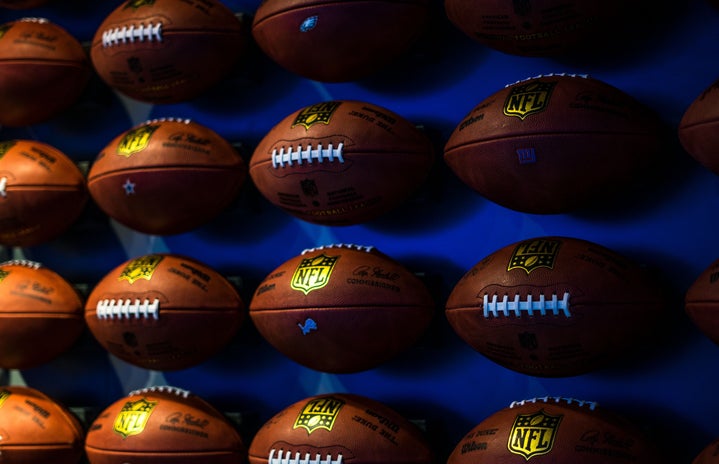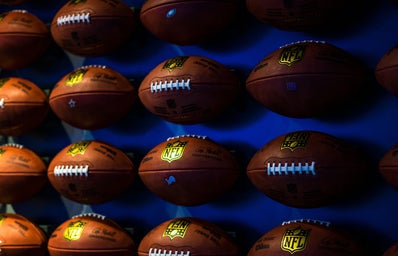Each year I look forward to the first hints of fall when there is a perfect amount of chill in the air. To me, that perfect chill in the air brings the promise of the football season with it. There is truly nothing better than gathering around the TV, decked out in your favorite team’s merch, ready to cheer them on. What I don’t love about game day, however, is the danger that comes with a contact sport, specifically the head-to-head collisions in football. The 2024-2025 NFL season is already panning out to be a fierce season, but the NFL League has made a few changes regarding players’ safety that are sure to make the season look a little different. While watching pre-season, I was taken aback by the large “bubble-like” helmets the players were wearing during their practices. These new protections to the helmets, known as Guardian Caps, may look strange to the eye, but could possibly do wonders to protect our favorite players.
Guardian Caps, although taking the media by storm during this season’s pre-season, are not a new concept. They were first introduced back in 2010 and have slowly been adopted by college and pro-teams. The Guardian Caps, created by the brand Guardian Sports are advertised as “additional soft-shell coverings that cover the player’s existing helmets.” The Guardian Caps are made out of a closed cell foam, covered in a spandex fabric and connected to the player’s existing helmet by velcro. In theory, these additional coverings provide an extra layer of protection to the football players’ heads.
Guardian Caps have started to increase in popularity as more studies have shown just how dangerous the helmet-to-helmet contact in football really is. In the NFL especially, many players suffer from multiple concussions throughout their careers. Repeated hits to the head in football can be life-threatening and cause lasting brain damage and progressive neurodegeneration. The degeneration of brain cells is known as chronic traumatic encephalopathy or CTE for short. CTE is associated with second impact syndrome, in which a second head injury occurs before the previous head injury has had enough time to fully heal. These head injuries cause the death of nerve cells in the brain, which can lead to trouble with thinking and emotions as well as physical problems. The increase in knowledge surrounding CTE has led to a shift in the league in wanting to prevent these head injuries. The NFL has since turned to Guardian Caps to decrease the possibility of CTE.
The increased knowledge of CTE and a movement around the prevention of it came into fruition back in 2022 when the NFL first mandated the use of Guardian Caps during training practices. In 2023, they expanded the requirement to include all regular practices as well. This year, however, the players have now been given the option to wear the Guardian Caps in regular season games. Whether the players do strap on the extra level of protection is up to them, and something to look out for. According to some players during preseason, the Guardian Caps are not loved by all. Seattle Seahawks defensive tackle Jarren Reed told the Seattle Times that “[he] hate[s] them.” Stating, “I understand the safety for them, but I’ve been playing a long time. It just looks crazy to me.” Similarly, Philadelphia Eagles cornerback Darius Slay spoke with CBS Sports and said, “I can’t stand them. It impacts my swag.” Clearly, there are divided views of the Guardian Caps between the players and fanbases, but many can agree on the importance of protecting the players. Mixed reviews of the Guardian Caps not only stem from their interesting appearance and feel, but also the lack of studies and data showing whether they are truly protecting the players.
Many lab studies surrounding Guardian Caps have shown very little improvement in impact when helmets have that extra layer of protection. The lab studies have shown that Guardian Caps can slightly reduce head impact forces, but their effects are less pronounced in high quality helmets. Also, there is a lack of data on whether the Guardian Caps can help prevent concussions, which ultimately leaves fans and players alike skeptical. To gain more information on the topic, I reached out to Anthony P. Kontos PhD, Director of Research for the UPMC Sports Medicine Concussion Program and Associate Professor and Vice-Chair Clinical Researcher in the Department of Orthopedic Surgery at the University of Pittsburgh. He states that with the players wearing the Guardian Caps during training camp, “the NFL reported a reduction in head injuries during that time, compared to previous samples.” Due to the recent change to letting the Guardian Caps be worn during the regular season games, researchers, including Dr. Kontos, are still eagerly waiting to see what the effects will be within the games. Dr. Kontos says that, “estimates suggest that no more than 5-10% of players will actually wear [Guardian Caps] this season.” When asked whether he believes Guardian Caps will become required during games in the future, Dr. Kontos stated that, “it will depend a lot on what evidence is developed to support their use this year.” He believes that a lot more research is needed in the area on all levels of sport from the NFL to youth football.
So, as the football season kicks off, make sure to wear your cutest merch, eat delicious snacks, scream your loudest at your TV or at the game and keep an eye out to see if any players decide to wear the Guardian Caps.


